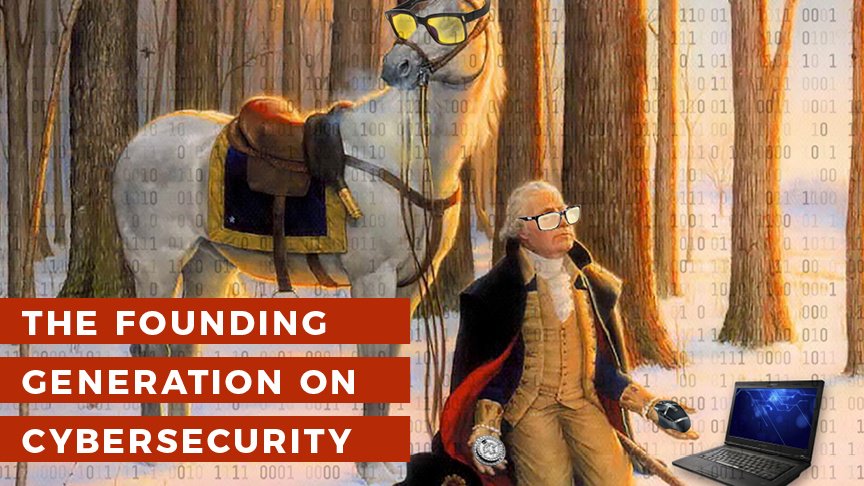The Founding Generation on Cybersecurity
Picking the Founders’ Brains
The ghosts of the Founding Generation are especially active around Independence Day. And these spirits still have much to share, teach, and pass on. The Founders had great foresight, so we can depend on their thoughts, writings, and actions to solve today’s problems, even modern issues like cybersecurity.
The Founders felt that America was a nation uniquely blessed by nature. Among those blessings were two oceans which protected it from foreign invasion. Indeed, for a couple of centuries, it was. But, today, the idea that physical separation or geographic barriers offer protection against cyber attack is dangerously naïve.
“…Our cause is the cause of all mankind, and that we are fighting for their liberty in defending our own.”
So is the only path to safety to close down commerce and operations that use Internet-connected computers? Shall we retire our credit cards and pay in whisky barrels as the people of the founding generation did? The founding generation would object. Their ideas about political liberty were intertwined with their ideas about commercial liberty. They admired entrepreneurship and personal industry. George Washington, in a 1784 letter, expressed his peers’ common sentiment about people’s sense of industry: “A people…who are possessed of the spirit of commerce, who see, and who will pursue their advantages, may achieve almost anything.”
The Founders would also certainly comment that while cybersecurity is a global issue, America can take lead on solving it. Benjamin Franklin’s 1777 letter to a friend explaining the stakes of the American Revolution then underway remains relevant today: “…Our cause is the cause of all mankind, and that we are fighting for their liberty in defending our own.”
Approaching the Cybersecurity Problem
So if the Founders thought assaults on liberty to be an American issue and responsibility, how would they approach this modern digital assault? For answers we can look to their most defining struggle, the War for Independence.
New Fortunes Forged at Valley Forge
Heading into the winter of 1777, the Continental Army was an inexperienced, under-supplied, and beleaguered unit facing a much-larger, established, and capable British army. A British officer described the weakened state of Washington’s troops: “Their army is broken all to pieces…one may…pronounce that it is well over with them.”
Since we now celebrate American independence, we know American fortune changed and Washington’s troops managed to put the pieces back together and defeat the British Army. How did they manage such a dramatic change and unlikely victory? Historians agree that the winter at Valley Forge in 1777 had much to do with the historical upset.
Valley Forge was intended to be a respite to war; an opportunity for American troops to rest and recover before the warmer weather brought more battles. But Washington had another goal in mind during the winter encampment: “…training the Men… [have them] gain some knowledge of the most essential manoeuvers.” Washington knew that only a well-trained army could defeat the more powerful and experienced enemy.
Up until that point training was mainly literature-based. In fact, General Henry Knox won his post by owning a bookstore and reading his inventory of military history. At Valley Forge, Washington called upon a Prussian captain, Friedrich Wilhelm Ludolf Gerhard Augustin, Baron von Steuben (his name ought not to count against my blog word length) to train his troops with hands-on drills and maneuvers. He taught the soldiers not just the theory of war, but how to practice it. Steuben instructed the troops how to stand, dress, march, reload a musket, and clean a bayonet. Steuben chose a capable group of one hundred troops and personally trained them. He then sent them out to “spread the instruction” to other units. Good military principles and practices, a result of rigorous and inspired training, propagated throughout the Valley Forge camp and onto the battlefield.
These practical skills training turned the Continental Army from a “raw, confused, unwieldy flock” into a professional fighting force. With the help of the French and British incompetence, the Colonial flock miraculously won American independence.
What We Can Learn
Washington’s army’s pre-Valley Forge was not much different than today’s cyber workforce. As evidenced by the seemingly endless stream of notable security breaches, our modern cyber workforce is under-educated and under-trained to take on sophisticated enemies. A strong workforce, as Washington and Steuben noted over 200 years ago, is developed through hand-ons, skills-based training in addition to general education and knowledge.
Washington’s army only became victorious when they became professional. Our nation’s livelihood, once again, rests of the professionalization of its defense force.
Works Cited
Buchanan, John. “The Road to Valley Forge: How Washington Built the Army that Won the Revolution.” (2007). New York: Barnes & Noble.
Freedman, Russell. “Washington at Valley Forge.” (2008). New York: Holiday House.
Trussell, J. B. Birthplace of an army: A Study of the Valley Forge Encampment. (1998). Harrisburg: Commonwealth of Pennsylvania, Pennsylvania Historical and Museum Commission.
Lockhart, Paul. “Baron von Steuben: “Drillmaster of the American Revolution.” (1962). Albany, NY: University of the State of New York, State Education Dept.

